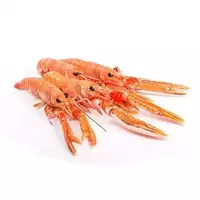Langoustine

Langoustine is one of the representatives of marine crustaceans. In appearance, it is very similar to a lobster, but a distinctive feature of langoustine is its small size, which in an adult hardly exceeds 25 centimeters. In other words, a little less river cancer. The langoustine has ten legs, thin long claws, as well as a carapace pointed downward, colored yellowish pink.
Many names are known for this crustacean: in some European countries it is called Norwegian lobster, the inhabitants of the British Isles call it Dublin shrimp, while in Italy the name scampi is most common. The traditional habitat of langoustine is considered to be the northeast Atlantic Ocean. At the same time, a wide fishery of langoustine is carried out in the Adriatic and North Seas, and Great Britain is recognized as the leading supplier of this crustacean on the world market.
In general, seafood, which enters the shelves of modern stores, can be divided into 2 species: large langoustine (up to twenty-five centimeters) and medium (about twelve centimeters). By the way, in the process of transporting these crustaceans, a certain kind of complexity often arises, since they are almost unable to live without water. In addition, freezing langoustines is extremely undesirable - when frozen, their meat becomes loose, losing most of its excellent taste.
When choosing seafood, the quality of langoustine is determined by the smell. So, in the absence of a characteristic fish smell at the bend between the shell and tail, we can talk about the freshness of langoustine. The quality meat of the crustacean, which is located in its tail part, is characterized by a very refined, tender and slightly sweet taste. Despite the rather large size of the claws, there is practically no meat in them.
Langoustine rightfully refers to marine delicacies and is used in the preparation of dishes of many world cuisines. For example, Japanese cuisine offers a dish of poses called "tempura, " which consists of meat from this crustacean, fried in batter. It's not uncommon for French chefs to add langoustine meat to an Orthesian soup, as well as their famous bouillabaisse. In Italy, langoustine is used as one of the ingredients for making risotto, and Spanish culinary experts like to add its meat to paella.
It is worth noting that before getting the meat, langoustine is immersed in boiling water for half a minute. However, with a longer temperature treatment, the meat acquires a "rubber" texture, losing its excellent taste. They cut the carcass, as a rule, immediately after cooking - at first they carefully separate the head, split the shell with a blunt object and gently squeeze the meat out of the tail. By the way, the shell, claws and head can be used in the preparation of sauces or broths, since these parts of the carcass are unusually fragrant.
langoustine 112 kCal
Energy value of langoustine (Ratio of proteins, fats, carbohydrates - ju):
Proteins: 20.6 g (~ 82 kCal)
Fats: 1.51 g (~ 14 kCal)
Carbohydrates: 2.43g (~ 10kCal)
Energy ratio (b | y): 74% | 12% | 9%
 Español
Español Français
Français Português
Português Русский
Русский 简体中文
简体中文 繁體中文
繁體中文 日本語
日本語 한국어
한국어 العربية
العربية Türkçe
Türkçe Қазақ
Қазақ Deutsch
Deutsch Italiano
Italiano Українська
Українська
